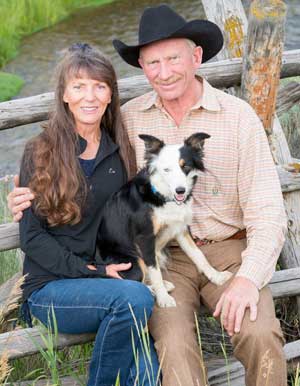
Karl Tyler with his wife Donna and Zip.
Tyler family inks $11 million conservation easement on Lemhi River to protect salmon spawning habitat
Karl Tyler always wanted to own a ranch in the Salmon area, having grown up there as a kid. He remembers watching the salmon spawn in the creek with his friends.
“My cousins and I used to fish this section of the river before snorkeling was popular with Fish and Game. We were snorkeling, looking at the salmon back in the ’60s,” Tyler says.
When Tyler went to college at the University of Idaho, he got a job washing cars at a local dealership, working for 90 cents an hour. “I was working in the shop and running the wrecker at night,” he says. “And I used to joke with the owner that I was going to be his top salesman.”
Turns out that Tyler wasn’t joking. The hard-working kid from Salmon not only became a top salesman. He ended up buying the dealership. Today, he owns several car dealerships in the Intermountain West, including Karl Tyler Chevrolet & Cadillac in Missoula, Montana, just over the hill from Salmon.
“Once I got the Chevy dealership in Missoula, I saw where it might be possible to eventually own a ranch, which had been my goal since the early 1960s,” Tyler says. “In 1994, I bought this place from Jack and Betty Powers, super nice people. They were concerned about the salmon and the trout; they worked with Trout Unlimited, to protect the habitat here as well.”
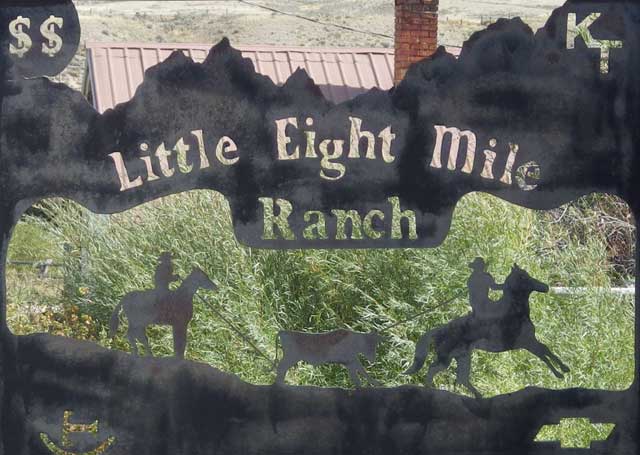
The sign for the Little Eight Mile Ranch features the Chevy logo, Tyler’s initials and one of their livestock brands.
It’s called the Little Eight Mile Ranch, nestled in the lush Lemhi River bottoms. The ranch includes approximately 20,000 acres of deeded land, 10 miles of prime Chinook salmon spawning habitat, and more premium habitat in Big Springs Creek, a large spring-fed stream that also winds through the ranch.
They run a commercial cow-calf operation and a registered cow-calf operation, and they have permits to graze livestock on national forest, state and Bureau of Land Management property above the ranch.
Tyler has been thinking about preserving the salmons pawning areas in the Lemhi River for years. Snake River Chinook salmon have been listed as a threatened species since 1992. He’s been approached multiple times by people and organizations that wanted to buy the ranch because of its high environmental and recreational values.
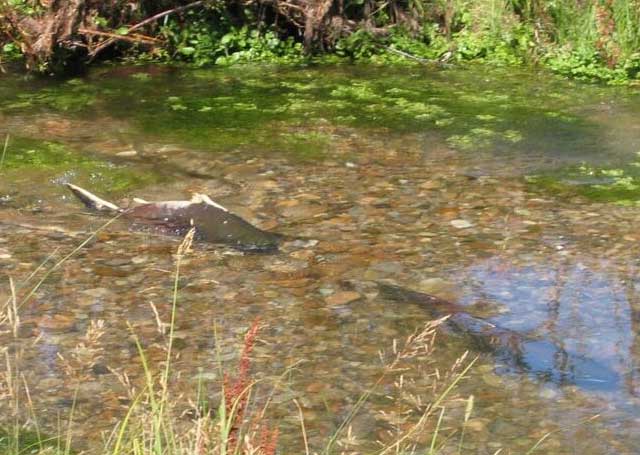
The Little Eight Mile Ranch contains premium spawning habitat for Chinook salmon. The fish swim about 800 miles to their spawning grounds from the Pacific Ocean, climbing over 8 dams along the way.
“The salmon, 60-80% of the redds are right here on this stretch of the river, so it’s real important to me that we protect those,” Tyler says. “Because I remember how much I enjoyed the salmon when I was 10-12 years old.”
Tyler’s ranch lies in the Salmon River Basin, where multiple agencies have been working on improving fish-habitat on private lands with voluntary landowners through the Upper Salmon River Basin Watershed Project, based in Salmon. The Governor’s Office of Species Conservation is the project lead along with the Bonneville Power Administration (BPA), The Nature Conservancy, the Idaho Department of Fish and Game, local soil and water conservation districts and more.
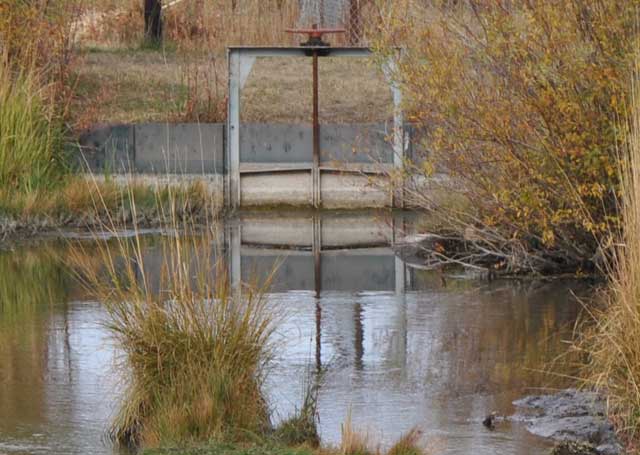
As part of the conservation easement, Tyler retired a water right for the L-63 diversion to increase in-stream flows on the Lemhi River for resident and ocean-going fish.
But Tyler wanted to make sure that any conservation efforts on his ranch were blended with the ranch operations so he could continue to raise cattle and run a working ranch.
“Carl Lufkin, my ranch manager, and I started talking about 10 years ago about what we could do to improve the ranch and keep the ranch’s integrity for agriculture,” Tyler says. “We talked to several groups and they were pretty closedminded to agriculture, didn’t understand agriculture, they were all worried about subdividing … they didn’t have the same goals that I did.”
But then Tyler approached Kristin Troy, executive director of the Lemhi Regional Land Trust. Troy is a native of Salmon, Idaho. She knows the local culture. The Lemhi Regional Land Trust has brokered a number of conservation easements in the valley over the last 10 years, with increasing local support and trust.
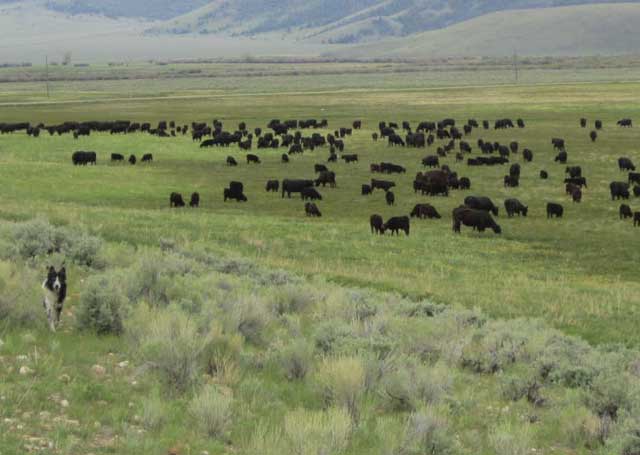
Angus cattle graze in the broad meadows of the Little Eight Mile Ranch under the shadow of the Beaverhead Mountains.
“Kristin understands both sides of this,” Tyler explains. “She understands how important agriculture is to Lemhi County, but also understands that ranching and farming can improve the habitat for wildlife, like we did for the sage grouse. We have more game on this ranch than I’ve ever seen in my life! More elk, more deer, more antelope, more sage grouse than there was when I was a kid.”
It took more than four years for Troy to work out the details of a conservation easement with Tyler. Potential funding partners included the BPA and the Idaho Governor’s office of Species Conservation.
“We really helped build a bridge between our funding partners, our science-based partners, and the landowner who’s on the ground — that’s really our job,” says Troy. “And that was a big challenge because the outcomes our science-based partners are looking for, funders were looking for, were serious outcomes that the landowner had to think long and hard about.”
In other words, Troy had to work with Tyler to figure out how to balance the needs and demands of the funders and science-based partners who might be primarily focused on fish-habitat needs, with the needs of running an economically viable cattle ranch. . It wasn’t easy.
The science-based partners that Troy refers to include the Idaho Department of Fish and Game, BPA, National Marine Fisheries Service, Bureau of Land Management, and U.S. Forest Service, among others. “It’s a collective conversation,” Troy says.
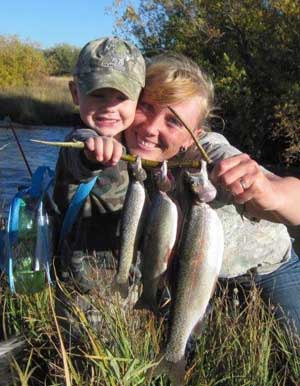
The Tyler family likes to fish and hunt, too. They catch lots of nice trout in the Lemhi River. Here, daughter Kristine catches fish with her son, Braxton.
“Some of the outcomes that our funders and science-based partners had seemed pretty steep and not automatically just doable right out of the gate,” she says. “We’re talking about water-saving measures, we’re talking about changing up management, we’re talking about keeping a certain level of water in the stream all the time, those are really big issues.”
One of the key provisions for salmon was for the Tylers to retire an irrigation diversion, L-63, to leave more water in the Lemhi River for fish.
“He is giving up a significant diversion and a significant water right,” Troy says. “That water was actually going across the highway to irrigate a field. Now, it’s going to stay in-stream in a part of the Lemhi that our biological partners say is really flow-limited. That was a huge issue.”
Even before the negotiations began, Tyler and his ranch manager Carl Lufkin had fenced the river bottoms to protect salmon spawning areas from cattle. The fences help with cattle management. “With the fencing we’ve done along the river to protect the habitat, we’re able to make smaller breeding pastures for our registered animals, so that’s worked out really well,” Tyler says.
“The big thing I find is that it helps us so we don’t overgraze any particular pasture. We can keep cows in a particular area, and keep track of the grass and what they’re doing there, and we can move them.”
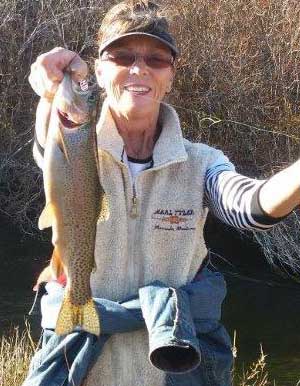
Donna with a nice fish.
Tyler also leaves one of his alfalfa fields watered by a pivot for sage grouse and antelope. “We have one pivot that we don’t cut, for two reasons. It’s a little bit rocky, but by not cutting it, it gives us fall pasture for our cows, and it gives the sage grouse and the antelope really good habitat,” he says. “There wasn’t any sage grouse here when I bought the ranch.”
Over time, Troy and Tyler worked through all the issues to complete an $11 million conservation easement. It protects about 10 miles of prime salmon spawning habitat along the Lemhi River and it covers 4,682 acres on the ranch.
“We ended up getting all of the outcomes that were hoped for and wished for, but I thought we did a great job as a group refining those along the way and tweaking them so we could say yes to permanence,” Troy says.
“The way we run the ranch, I don’t really consider these to be sideboards, I consider it to be good management,” Tyler says. “Down the road, people will see that this is a really good thing not just for today but long term. This is going to be a really good thing for salmon, for agriculture and for Lemhi Valley.”
Tyler credits the Governor’s Office of Species Conservation for helping make the deal happen. Mike Edmondson, program manager for the Governor’s Office of Species Conservation, spent many hours on the project, helping Troy with balancing the demands of science-based partners.

The Tylers share their ranch with lots of wildlife, including elk, moose, bighorn sheep and antelope.
“Ranching and anadromous fish are completely compatible, especially when you’re working with a team of folks, where all of the concerns can be aired, and solutions can be discussed,” Edmondson says. “That is what has really built confidence with the landowner.”
“Through our partnership with the Bonneville Power Adminis- The Tylers share their ranch with lots of wildlife, including elk, moose, bighorn sheep and antelope. tration, we were able to contribute $8 million through the Idaho Fish Accords, and then $3.5 million came from the state of Idaho’s Snake River Basin habitat trust fund.”
The Bonneville Power Administration wants to improve salmon spawning habitat in the Salmon River Basin. The Tyler property fits that objective perfectly, Edmondson says.
“This property has offered more to do that than any single other property in the upper Salmon, if not the whole state of Idaho, so there’s always a high level of interest in this,” he says.
Karl Tyler gives kudos to both Troy and OSC. “Kristin worked harder than anybody I’ve ever seen work in my life to get this accomplished. The state of Idaho is the only reason that this worked.”
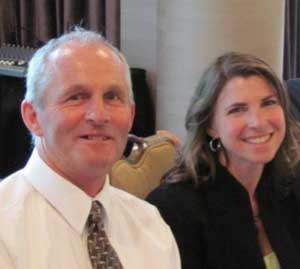
Rancher Merrill Beyeler, chairman of the Lemhi Regional Land Trust, and Kristin Troy, executive director. Tyler said he felt more comfortable working with a local land trust that understands ranching and conservation.
Troy credits her two-person staff in helping her with many hours of support work to help make the project a success. “There is a great deal of support work that goes into an crafting an easement – creating maps over and over and many real estate due diligence items that were very complicated at this scale,” Troy says. “All of this was accomplished with an enormous amount of scrutiny.”
Officials with the Bonneville Power Administration are pleased with the conservation easement acquisition. BPA’s funds for the project came from the 2008 Columbia Basin Fish Accords, which supports mitigation for the Columbia and Snake river dams. The Idaho Accord, signed by the state of Idaho, BPA, the U.S. Army Corps of Engineers and the Bureau of Reclamation, provides $41.3 million for the permanent protection of fish and wildlife habitat through land purchases and conservation easements. In addition, the agreement provides capital funding for expansion of the Snake River Sockeye Hatchery Program. Snake River sockeye are listed as endangered under the Endangered Species Act.
“The protection of this critical habitat for fish is great news for everyone who values the region’s iconic salmon runs,” says BPA Deputy Administrator Greg Delwiche, who spoke at a special ceremony in late October with Gov. Butch Otter, the Lemhi Regional Land Trust, OSC and Leadore Land Partners. “The BPA funding of this conservation easement is a strategic investment of ratepayer funds that will go a long way toward the re Rancher Merrill Beyeler, chairman of the Lemhi Regional Land Trust, and Kristin Troy, executive director. Tyler said he felt more comfortable working with a local land trust that understands ranching and conservation. building of our endangered stocks of salmon and steelhead.”

Lemhi Land Trust
“This historic agreement will help us move toward recovery and eventual delisting of chinook salmon in Idaho,” said Gov. Butch Otter, who personally visited the property on several occasions. “I know conservation easements are neither a cure-all nor the best solution in every circumstance. But this agreement works, and it further demonstrates that cattle ranching is compatible with the needs of native fish and wildlife.”
Jeff Diluccia, staff fish biologist for the Idaho Department of Fish and Game in Salmon, said the 10-mile reach of the Lemhi River conserved under the easement deal “is probably one of the most significant, if not the most significant easements/acquisitions we could do in the entire upper Salmon River Basin. The Lemhi River was a very large historic producer of chinook salmon. The property and habitat that exists on the Tyler Ranch is some of the best, if not the best habitat in the Lemhi Basin for chinook salmon. In a year like last year, where we had 230 redds (nests), you counted 100 or more on the Tyler property. Yeah.”

This little feller, Braxton, middle, could be the next generation to run the Little Eight Mile Ranch, along with his sister, Alexa, right. Also pictured is Angel Crosthwaite on the left.
Leodore rancher Merrill Beyeler owns ranch property upstream and downstream of Tyler’s ranch. He’s inked conservation easements with The Nature Conservation himself, and he, as chairman of the Lemhi Regional Land Trust, helped Troy navigate through the details over the years along with the other members on the Land Trust board. He’s very supportive of the agreement.
“When you begin to look at the Karl Tyler conservation easement on the Lemhi, I think it probably has the heart of the Lemhi. It’s the most important conservation easement that we’ve done and certainly the most complicated that’s been done,” Beyeler says. “It’s a great win for our community, a great win for the valley. I was talking to a young man on Sunday, and he said, I wish I could freeze this moment in time. There’s sort of that feeling of wellness in our valley. And I think you can’t beat that.”
Steve Stuebner is the writer and producer of Life on the Range, a public education project sponsored by the Idaho Rangeland Resource Commission.
© Idaho Rangeland Resources Commission, 2015

